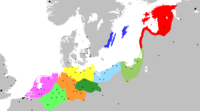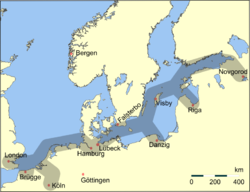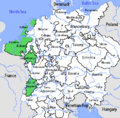Zutphen
| Zutphen | |||
|---|---|---|---|
| — Municipality — | |||
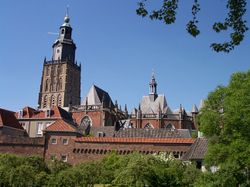 |
|||
|
|||
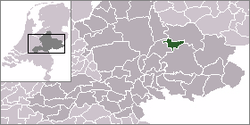 |
|||
| Coordinates: | |||
| Country | Netherlands | ||
| Province | Gelderland | ||
| Area(2006) | |||
| - Total | 42.84 km2 (16.5 sq mi) | ||
| - Land | 41.00 km2 (15.8 sq mi) | ||
| - Water | 1.84 km2 (0.7 sq mi) | ||
| Population (1 January 2007) | |||
| - Total | 46,709 | ||
| - Density | 1,139/km2 (2,950/sq mi) | ||
| Source: CBS, Statline. | |||
| Time zone | CET (UTC+1) | ||
| - Summer (DST) | CEST (UTC+2) | ||
![]() Zutphen is a city in the province of Gelderland in the Netherlands. It lies some 30 km north-east of Arnhem, on the Eastern bank of the river IJssel at the point where it is joined by the Berkel. The name Zutphen (first mentioned in the eleventh century) appears to mean 'zuid-veen', or in English, south-fen.
Zutphen is a city in the province of Gelderland in the Netherlands. It lies some 30 km north-east of Arnhem, on the Eastern bank of the river IJssel at the point where it is joined by the Berkel. The name Zutphen (first mentioned in the eleventh century) appears to mean 'zuid-veen', or in English, south-fen.
In 2005, the municipality of Zutphen was merged with the municipality of Warnsveld, retaining its name. The municipality has about 47,000 inhabitants.
Zutphen, is Also twinned with English town Shrewsbury (pronounced Shrews-bree) which is in the midlands county of Shropshire
Contents |
History
About 300 AD a Germanic settlement was the first permanent town on a complex of low river dunes. Whereas many such settlements were abandoned in the early Middle Ages, Zutphen on its strategic confluence of IJssel and Berkel stayed. After the incorporation of the IJssel lands in Charlemagne's Francia, Zutphen became a local center of governance under a count. The Normans raided and ravaged it about 900. Afterwards a system of walls was built to protect the budding town.
In the eleventh century Zutphen was a royal residence for a number of years; a pfalz was built, together with a large chapter church, the predecessor of the present St. Walburgis. The counts of Zutphen acquired a lot of power, until the line of counts became extinct in the twelfth century. After the death of her father and her brother, Ermgard, the heiress of Zutphen married the count of Guelders; her son Henry I, Count of Guelders was the first to wear both titles.
The town received city rights between 1190 and 1196, making it one of the oldest cities in the country. Only Utrecht, Groningen and Deventer preceded it in receiving city rights. Zutphen, in turn, granted city rights to several other cities, such as Arnhem, Doetinchem, Lochem and Harderwijk. It also became part of the Hanze, a group of cities with great wealth, this group of cities were the economic center in that part of Europe.
The largest and oldest church of the city is the St. Walburgis (Saint Walpurga) church, which originally dates from the twelfth century. The present Gothic building contains monuments of the former counts of Zutphen, a thirteenth century candelabrum, an elaborate copper font (1527), and a modern monument to the Van Heeckeren family. The chapter-house ("Librije") contains a pre-Reformation library which includes some valuable manuscripts and incunabula. It is considered one of only 5 remaining medieval libraries in Europe (the other 4 being in England and Italy respectively). The old books are still chained to their ancient wooden desk, a habit of centuries ago, dating from the times the library was a "public library" and where the chains prevented the books from being stolen.
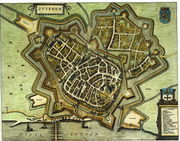
Having been fortified the town stood several sieges, specially during the wars of freedom waged by the Dutch against Spain, the most celebrated fight under its walls being the Battle of Zutphen in September 1586 when Sir Philip Sidney was mortally wounded. Taken by the Spaniards in 1587 by the treachery of the English commander Rowland York, Zutphen was recovered by Maurice, prince of Orange, in 1591, and except for two short periods, one in 1672 and the other during the French Revolutionary Wars, it has since then remained a part of the Netherlands. Its fortifications were dismantled in 1874.
Modern city
The old center survived the Second World War almost in its entirety, though some parts of the city were lost, especially the area around the railway station, in the northern part of the city center, known as the Nieuwstad (English: New City). The city center includes many monumental buildings dating back to the 16th and 17th centuries, and some even date back to the 13th century such as a retirement home area. There are also remains of the old town walls in several places.
Today, Zutphen is a modern small city. The urban area, which includes the town of Warnsveld, has about 51,000 inhabitants. Stores are opened from 9:30 to 18:00 (6 p.m.) on weekdays, on Friday evening until 21:00 (9 p.m.) and on Saturday until 17:00 (5 p.m.). Some stores open earlier, and the larger supermarkets usually stay open until 22:00 (10 p.m.)
Regional center
Juridical centre
Zutphen, although a relatively small city, houses one of the Netherlands' 19 courts, the national training institution for judges and public prosecutors (SSR), the national police academy for senior police investigators, three prisons and a large number of lawyers. It is the early emergence of Zutphen in the Middle Ages as the main city of a county that explains its current position in the juridical system.
Besides a 'normal' prison, one may find in Zutphen the JPC de Sprengen penitentiary facility for boys. There are several buildings: new institutions replacing the old facilities, but the old prisons remained open after completion of the new facilities. Only the old prison called Lunette did not meet today's standards and has closed in 2008.[1]
Medical center
Located in Zutphen is the "Spittaal" location of the Gelre Ziekenhuizen (Gelre Hospitals) group. This is a regular hospital offering all common specialties (no cardio-thoracic or neurosurgery) and a 24/7 emergency department. It is located in the southeastern part of the city, in the district of Leesten. A new hospital is due to be built soon to replace the old building, which dates from the 1970s. The new hospital will be built adjacent to the old one and is due to be completed in 2010.
A sizable number of practitioners of alternative medicine is located in Zutphen.
Educational center
Zutphen is home to several well-known schools for secondary education on all levels. These include the "Stedelijk Dalton College", "Baudartius College", "Vrije School Zutphen", (a "Vrije School" being a Waldorf School) and "Isendoorn Lyceum" (located in Warnsveld). Students from a wide area around Zutphen learn at these schools.
Transportation
Rail
- Zutphen railway station
Zutphen is an important regional railway center. The main electrified lines to Deventer and Zwolle in the north, and to Arnhem in the south, are run by the national railway company Nederlandse Spoorwegen (NS). The secondary lines to Winterswijk and Hengelo are operated by Syntus. The regional rail service to Apeldoorn is run by a special subsidiary of the NS. All secondary lines run diesel trains. Zutphen's old station building (1863), upgraded in 1875, was partly destroyed during World War II. In the early 1950s a modern new station was erected, a typical post-war building with concrete as its main material.[2] However, in October 2007 the station building was designated as a State Monument. In 2006 and 2007, the area surrounding the railway station was completely renovated: a new bus terminal and an underground bicycle parking lot were constructed, and the main road leading from the railway station to the city center was turned into a road for pedestrians and cyclists only.
Road
Zutphen lies 10 kilometers south of the A1 motorway, which can be entered where it passes Deventer. From there the A1 leads East to Hengelo and West past Apeldoorn to Amsterdam. Main roads are the N348 (Arnhem - Zutphen - Deventer - Ommen), N314 (Zutphen - Doetinchem), N319 (Zutphen - Vorden - Winterswijk), N345 (Zutphen - Lochem - Hengelo), N826 (Zutphen - Almen - Laren).
Bus
Almost all buses in and around Zutphen are operated by Syntus. There are three internal city bus lines, and regional lines to Doetinchem, to Deventer and to Almen. The bus lines towards Vorden, Apeldoorn and Dieren were cancelled in the past; these towns and the destinations in between can now only be reached by car or by train.
Population centers
- Zutphen
- Warnsveld
- Warken
International relations
Twin towns — Sister cities
Zutphen is twinned with:
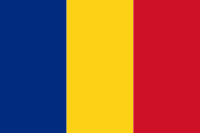 Satu Mare, Romania
Satu Mare, Romania Tartu, Estonia
Tartu, Estonia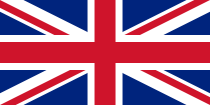 Shrewsbury, United Kingdom
Shrewsbury, United Kingdom Villa Sandino, Nicaragua
Villa Sandino, Nicaragua Horstmar, Germany
Horstmar, Germany
Delegations including the mayors of the cities visit each other, and developmental aid programs are in place with Satu Mare, Tartu and Villa Sandino.
People from Zutphen
- Gerard Zerbolt of Zutphen (1367–1398), mystical writer
- Jan Brandts Buys (1868–1933), composer
- Lambertus Doedes (1878–1955), sailor
- Jo Spier (1900–1978), illustrator
- Robert van Gulik (1910–1967), orientalist, diplomat, and writer
Photogallery
|
Zutphen (1654) |
Berkel gate (Zutphen) |
 IJsselkade (IJssel quay) by night |
 Town hall of Zutphen |
|
Drogenaps tower (Zutphen) |
 Wijnhuis tower (Zutphen) |
 IJssel bridge (Zutphen) |
 City wall (Zutphen) |
 City wall (Zutphen) |
Reference(s)
- ↑ Min. of Justice, Inspectie voor Sanctietoepassing (2007) (PDF). Inspectierapport Doorlichting PI Achterhoek, lokatie Lunette. http://www.inspectiesanctietoepassing.nl/images/Inspectierapport%20PI%20Achterhoek%20locatie%20Lunette_tcm56-75983.pdf. Retrieved 2008-05-05.
- ↑ Bramer, Wichor (updated 2008-01-31). "Station Zutphen". Railwaystations in the Netherlands. Stationsweb. http://www.stationsweb.com/zutphen. Retrieved 2008-05-05..
External links
- Official Website
- Photo Album of Zutphen (in Dutch only)
- Hanseatic Cities in the Netherlands
- Zutphen on Wikitravel
|
||||||||||||||||||||||||||
|
||||||||||||||||||||
|
|||||||||||


